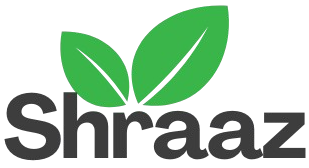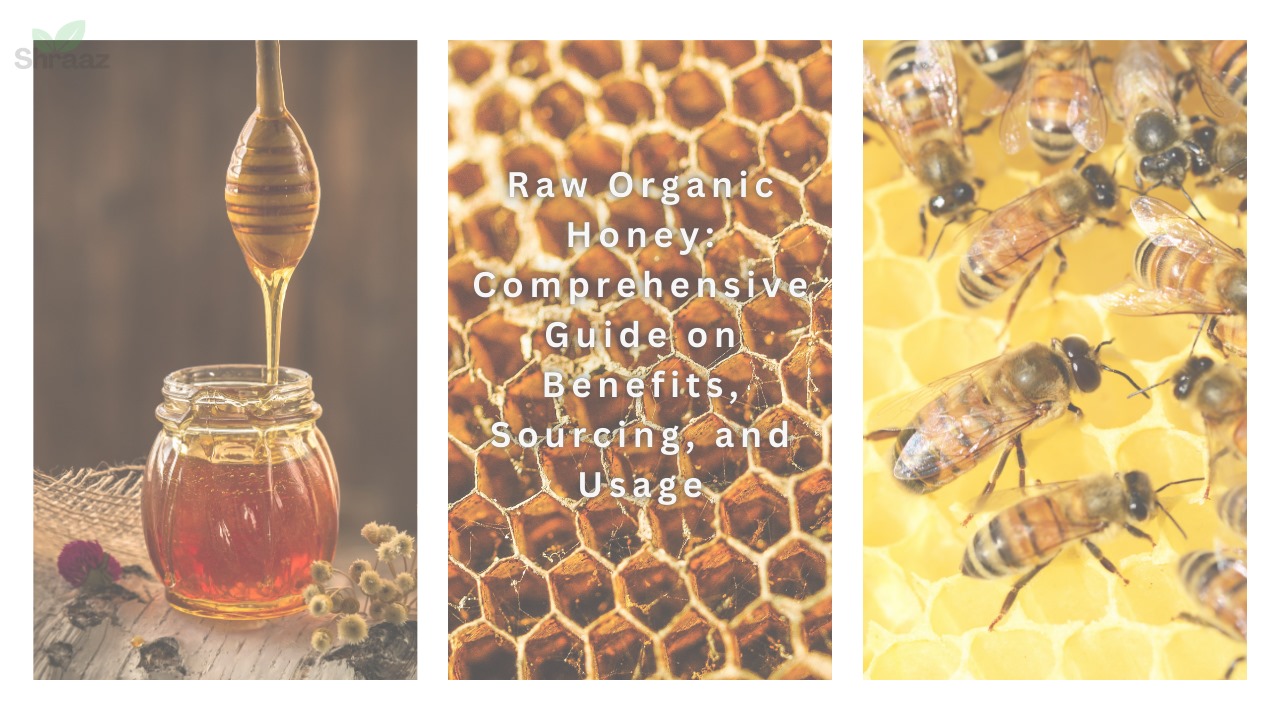Introduction to Raw Organic Honey
Raw organic honey has long been revered for its natural sweetness and medicinal properties. Unlike processed honey, raw honey is unpasteurized and unfiltered, meaning it retains its full range of beneficial nutrients and enzymes. As people increasingly seek natural alternatives for health and wellness, raw organic honey has surged in popularity. This guide provides an in-depth look at its nutritional profile, health benefits, sourcing practices, uses, and potential risks, giving you a holistic understanding of why this sweet substance has stood the test of time.
For a broader discussion of the overall organic foods beyond just honey, check out The Complete Guide to Organic Food/Edibles: Benefits, Characteristics, and Future Trends.
Nutritional Profile of Raw Organic Honey
Raw organic honey is a nutrient-dense food that contains a variety of essential vitamins, minerals, enzymes, and antioxidants. Since it’s unprocessed, it retains the majority of these natural components, making it a better alternative to refined sugars and processed honey. Below is an extensive look at its nutritional profile:
Macronutrient Breakdown
| Component | Amount per 1 tbsp (21g) |
| Calories | 64 |
| Carbohydrates | 17g |
| Sugars | 16g |
| Fiber | 0g |
| Protein | 0.1g |
| Fat | 0g |
Raw honey is almost entirely made up of natural sugars, primarily fructose and glucose. While high in sugar, it has a lower glycemic index (GI) than refined sugar, making it a better option for managing blood sugar levels.
Micronutrient Content
Raw organic honey is also rich in trace minerals and vitamins that are crucial for bodily functions. Though these nutrients are present in small amounts, they contribute to the overall health benefits of honey:
| Nutrient | Content (Trace Amounts) |
| Vitamin C | Yes |
| Calcium | Yes |
| Iron | Yes |
| Magnesium | Yes |
| Potassium | Yes |
| Zinc | Yes |
| Riboflavin (B2) | Yes |
| Niacin (B3) | Yes |
| Pantothenic Acid | Yes |
| Amino Acids | Yes |
Key Compounds in Raw Organic Honey
- Antioxidants: Raw honey contains flavonoids and phenolic acids, which help fight oxidative stress and inflammation in the body.
- Enzymes: Enzymes such as glucose oxidase help release hydrogen peroxide, giving raw honey mild antibacterial properties.
- Phytonutrients: Plant-derived nutrients in honey have immune-boosting and anti-cancer properties.
These elements are often lost during the pasteurization of regular honey, which makes raw organic honey a more nutrient-packed option.
Health Benefits of Raw Organic Honey
Raw organic honey has a multitude of health benefits, thanks to its unique combination of nutrients, enzymes, and antioxidants. From supporting the immune system to aiding digestion, the benefits of consuming raw honey extend far beyond just providing natural sweetness.
1. Antioxidant and Anti-Inflammatory Properties
Raw organic honey is rich in antioxidants like flavonoids and phenolic compounds, which help neutralize free radicals in the body. Free radicals can cause oxidative stress, contributing to chronic diseases such as heart disease and cancer. According to a study published in the Journal of Agricultural and Food Chemistry, raw honey’s antioxidant capacity can reduce inflammation, lower cholesterol levels, and support heart health.
2. Boosts Immune Function
The phytonutrients found in raw honey can enhance the body’s immune system. Honey’s antibacterial and antiviral properties come primarily from the release of hydrogen peroxide through enzymes, which help to fight infections. Consuming raw honey has been linked to faster recovery from minor illnesses like the common cold and sore throat.
3. Promotes Digestive Health
Raw honey can act as a prebiotic, promoting the growth of beneficial gut bacteria, such as Bifidobacteria and Lactobacilli. It can also soothe digestive issues like acid reflux, indigestion, and even gastritis, thanks to its anti-inflammatory properties.
Health Benefits Summary Table
| Health Benefit | Description |
| Antioxidant properties | Helps fight oxidative stress, lower cholesterol |
| Antibacterial effects | Fights infections through hydrogen peroxide release |
| Digestive aid | Promotes gut health and soothes gastrointestinal issues |
| Skin healing | Topical application accelerates the healing of wounds and burns |
| Cough suppressant | Reduces cough frequency and intensity, especially in children |
4. Wound Healing and Skin Health
Raw honey has been used for centuries as a topical treatment for wounds and skin infections. Its natural antibacterial and anti-inflammatory properties can help cleanse and speed up the healing of minor cuts and burns. Several studies have shown that medical-grade honey, such as Manuka honey, can be effective in treating skin conditions like eczema and acne.
5. Natural Cough Suppressant
One of the most well-researched benefits of raw honey is its ability to suppress coughs. In fact, a study published in Pediatrics found that honey was more effective at reducing nighttime coughs in children than standard over-the-counter cough suppressants.
Sourcing Raw Organic Honey
Finding high-quality raw organic honey can be challenging, as not all honey labeled as “organic” or “raw” meets the highest standards. Understanding the different sourcing methods, certifications, and regions can help you make informed purchasing decisions.
1. Organic Certification
To ensure that honey is truly organic, it must meet certain standards:
- No pesticides or chemicals: Organic honey comes from beehives located in areas where no chemical pesticides or herbicides are used.
- Beekeeping practices: Certified organic honey requires beekeepers to follow sustainable and eco-friendly practices, such as using natural treatments for mite control and preventing bee exposure to harmful chemicals.
- USDA Organic Seal: Look for honey labeled with the USDA organic certification or other reputable international standards.
2. Geographical Sourcing
The location where the honey is sourced can affect its flavor, texture, and nutritional content. Honey from different regions has unique characteristics, and certain types, such as Manuka honey from New Zealand, are prized for their potent medicinal qualities. Here are some examples of popular honey types based on geography:
- Manuka Honey (New Zealand): Known for high antibacterial properties.
- Sidr Honey (Yemen): A rare honey rich in nutrients that is used for medicinal purposes.
- Wildflower Honey (Global): Made from various flowers and generally has a mild flavor.
3. Ethical and Sustainable Beekeeping
Supporting ethical and sustainable beekeeping practices is crucial for the environment. Over-harvesting or mistreating bees can negatively impact bee populations and biodiversity. When sourcing honey, look for suppliers who emphasize bee health and sustainability, ensuring that bees are treated humanely and the ecosystem is preserved.
Usage of Raw Organic Honey
Raw organic honey is incredibly versatile, and its uses extend beyond just a natural sweetener for food and drinks. It can be incorporated into a variety of culinary, medicinal, and cosmetic applications. Below are the primary ways in which raw honey is used in everyday life, along with some creative suggestions for maximizing its potential.
1. Culinary Uses
Natural Sweetener
Raw honey can serve as a healthier alternative to refined sugar. It has a lower glycemic index (GI) than sugar, meaning it won’t spike blood sugar levels as drastically. When substituting honey for sugar, use a ratio of ¾ cup of honey for every 1 cup of sugar and reduce the liquid in recipes to account for honey’s moisture.
- In Tea and Coffee: Replace sugar with raw honey in your daily tea or coffee to enjoy a natural sweetness with added health benefits.
- In Baking: Honey can be used in baked goods like muffins, cakes, and cookies to give a richer flavor. Remember to lower the oven temperature slightly to prevent over-browning due to honey’s higher fructose content.
- Salad Dressings and Marinades: Use honey as a base for salad dressings, marinades, and sauces. Its natural sweetness complements savory and tangy flavors beautifully, especially in dressings for spinach, citrus, or nut salads.
Fermentation and Preservation
Honey has been used for centuries to preserve fruits and vegetables due to its antibacterial properties. It can also be used in fermenting beverages like mead, an alcoholic drink made from honey, water, and sometimes fruits or spices.
- Mead Making: Mead is one of the oldest alcoholic drinks, and the fermentation process relies heavily on the natural sugars in honey. This craft has seen a revival, with more people making mead at home.
- Honey-Pickled Vegetables: Some traditional recipes call for honey as part of the pickling process. Its natural sugars provide both flavor and a longer shelf life for preserved goods.
2. Medicinal Uses
Cough and Cold Remedy
One of the most popular medicinal uses of raw honey is for treating coughs and sore throats. Honey has natural antibacterial and antiviral properties that help soothe and reduce the irritation in the throat, especially when combined with warm water, lemon, and ginger.
- Homemade Cough Syrup: A simple cough syrup can be made using raw honey, lemon juice, and ginger. Mix 2 tablespoons of honey with the juice of one lemon and a small amount of grated ginger. Take 1-2 teaspoons as needed to relieve a sore throat or persistent cough.
Digestive Aid
Raw honey can also be used as a digestive aid. It promotes the growth of healthy gut bacteria and helps soothe symptoms of indigestion or acid reflux.
- Honey Water: Drinking warm water with a tablespoon of honey can help ease stomach discomfort and support digestion, particularly when taken first thing in the morning.
Wound Healing
Topical application of raw honey has been shown to promote faster healing of minor cuts, scrapes, and burns. Its antibacterial and anti-inflammatory properties make it effective at reducing infection and inflammation.
- DIY Wound Salve: Apply a small amount of honey directly onto the wound, cover it with a sterile bandage, and replace it as needed. This is particularly effective with burns, as honey not only soothes but also promotes tissue regeneration.
3. Cosmetic and Skincare Uses
Moisturizer and Skin Cleanser
Honey is a natural humectant, meaning it draws moisture into the skin. It can be used in face masks, cleansers, and exfoliants to improve skin hydration and complexion.
- DIY Honey Face Mask: Combine 1 tablespoon of raw honey with 1 tablespoon of yogurt or oatmeal for a hydrating and exfoliating face mask. Apply for 15-20 minutes before rinsing off with warm water.
Hair Care
Honey can also be used as a conditioning treatment for hair. Its natural enzymes and nutrients help restore shine, moisture, and softness to dull, dry hair.
- Honey Hair Rinse: Mix 1 tablespoon of honey with 2 cups of warm water and use as a final rinse after shampooing and conditioning your hair. This will add moisture and shine without leaving a sticky residue.
Lip Balm and Hand Cream
Raw honey can be added to DIY lip balms and hand creams for its hydrating and healing properties. It helps repair dry, cracked lips and hands, making it an excellent natural alternative to synthetic moisturizing products.
4. Natural Preservative
Due to its antibacterial properties, honey can also be used as a natural preservative in jams, jellies, and pickles. Its low water content and acidic nature prevent the growth of microorganisms, extending the shelf life of certain foods without the need for artificial preservatives.
Potential Risks and Considerations
While raw organic honey offers numerous health benefits and uses, there are also potential risks and considerations to be aware of. It’s important to consume honey responsibly, especially when it comes to vulnerable populations like infants and people with certain health conditions.
1. Infant Botulism
One of the most well-known risks associated with honey is infant botulism. Raw honey can contain spores of Clostridium botulinum, a bacterium that can produce harmful toxins in the digestive systems of infants. For this reason, honey should never be given to children under 12 months of age. After the age of one, the digestive system is developed enough to prevent the spores from germinating.
2. Allergic Reactions
Though rare, some individuals may experience allergic reactions to raw honey, especially if they are allergic to bee pollen or certain plant pollens. Symptoms of an allergic reaction can include itching, swelling, hives, and in severe cases, anaphylaxis. It’s always a good idea to consult a healthcare provider if you have known allergies to bees or pollen before consuming raw honey.
3. Blood Sugar Considerations
Even though honey has a lower glycemic index than sugar, it is still high in natural sugars. People with diabetes or blood sugar management issues should monitor their honey intake carefully, as consuming too much can cause blood sugar levels to rise.
| Consideration | Details |
| Infant Botulism | Avoid giving honey to children under 1 year old. |
| Allergic Reactions | Can cause allergic symptoms in sensitive individuals. |
| Impact on Blood Sugar | Monitor intake if diabetic or managing blood sugar. |
4. Excessive Caloric Intake
Honey is calorie-dense, with around 64 calories per tablespoon. While it’s healthier than refined sugar, it can contribute to weight gain if consumed in excess. Moderation is key, especially for individuals on calorie-restricted diets or those trying to lose weight.
5. Pasteurization and Adulteration Concerns
Not all honey labeled as “raw” or “organic” is truly raw or organic. Some brands may pasteurize their honey to improve its shelf life, removing many of the beneficial nutrients in the process. Others may adulterate honey with syrups or other sweeteners, reducing its nutritional value. To ensure you’re getting high-quality honey, always check for reputable certifications and sourcing information.
Conclusion
Raw organic honey is a powerhouse of nutrients, antioxidants, and health-promoting properties. It offers versatile uses in both culinary and medicinal applications, but it also comes with potential risks that consumers should be mindful of. Whether you’re using honey as a natural sweetener, skincare ingredient, or digestive aid, understanding its sourcing, benefits, and limitations can help you make informed decisions about incorporating it into your daily life.
FAQ
1. What is the difference between raw honey and regular honey?
Raw honey is unpasteurized and unfiltered, meaning it retains all of its natural nutrients, enzymes, and antioxidants. Regular honey is often processed, pasteurized, and filtered, which can remove many of these beneficial components.
2. Can I use raw honey if I have diabetes?
While raw honey has a lower glycemic index than refined sugar, it is still high in natural sugars. People with diabetes should consume honey in moderation and monitor their blood sugar levels carefully.
3. How can I tell if honey is truly raw?
Look for honey labeled as “unpasteurized” or “raw” and check for certifications like USDA Organic. Additionally, raw honey will often have a cloudy appearance due to its natural pollen, enzymes, and particles, unlike the clear, syrupy appearance of processed honey.
4. Is raw honey safe to use on wounds?
Yes, raw honey has natural antibacterial properties that make it effective for treating minor cuts, scrapes, and burns. However, for serious or deep wounds, medical-grade honey should be used under professional supervision.
5. Can raw honey help with seasonal allergies?
There is some evidence that consuming local raw honey can help alleviate seasonal allergy symptoms, as it may expose your immune system to small amounts of pollen. However, more research is needed, and this remedy is not universally effective.
6. How should I store raw honey?
Raw honey should be stored in a cool, dry place. It does not need to be refrigerated and has an indefinite shelf life due to its low moisture content and antibacterial properties. If your honey crystallizes, you can gently warm it by placing the jar in warm water to return it to its liquid form.




